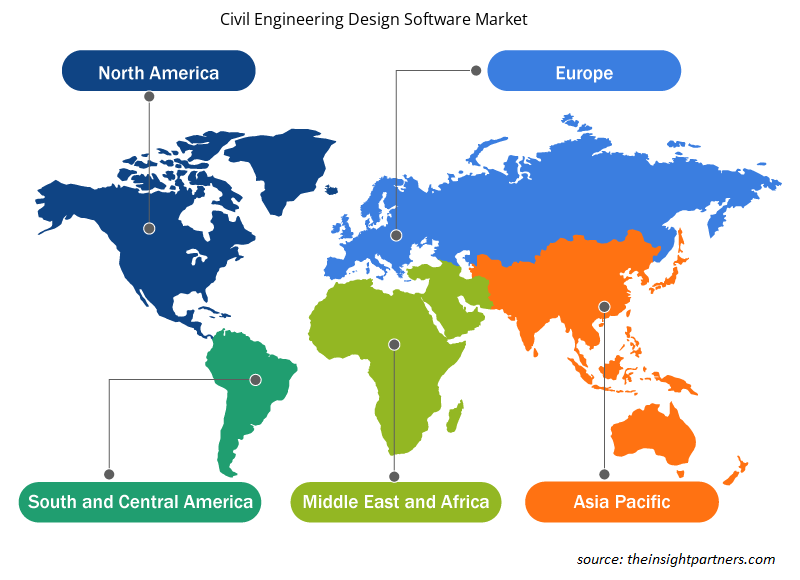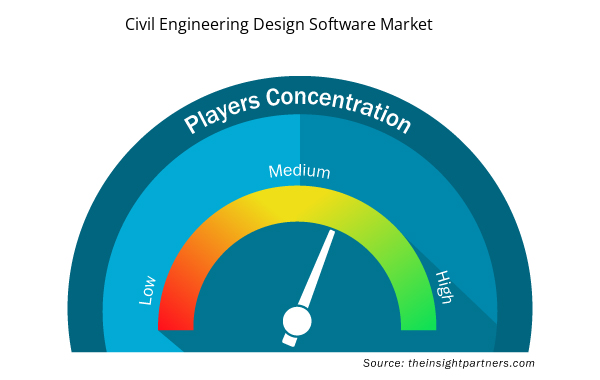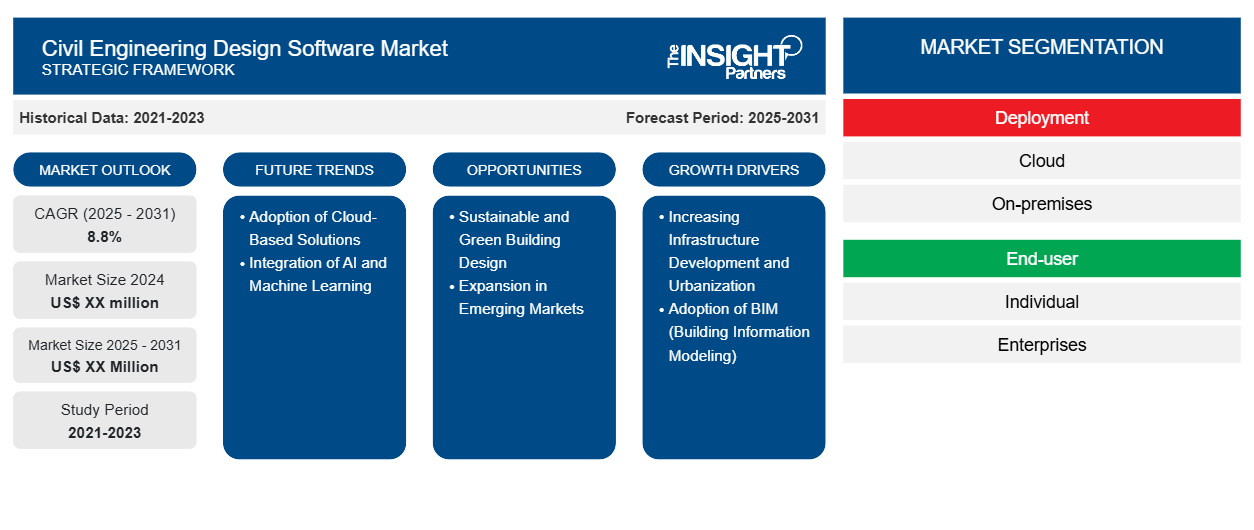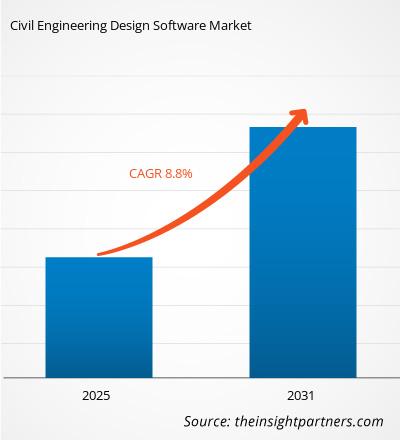Es wird erwartet, dass der Markt für Bauingenieur-Konstruktionssoftware von 2023 bis 2031 eine durchschnittliche jährliche Wachstumsrate (CAGR) von 8,8 % verzeichnet, wobei die Marktgröße von XX Millionen US-Dollar im Jahr 2023 auf XX Millionen US-Dollar im Jahr 2031 wächst.
Der Bericht ist segmentiert nach Bereitstellung (Cloud, vor Ort); Endbenutzer (Einzelperson, Unternehmen). Die globale Analyse ist weiter auf regionaler Ebene und nach wichtigen Ländern aufgeschlüsselt. Der Bericht bietet den Wert in USD für die oben genannte Analyse und Segmente.
Zweck des Berichts
Der Bericht „Markt für Bauingenieur-Designsoftware“ von The Insight Partners soll die aktuelle Landschaft und das zukünftige Wachstum sowie die wichtigsten treibenden Faktoren, Herausforderungen und Chancen beschreiben. Dies wird verschiedenen Geschäftspartnern Einblicke geben, wie zum Beispiel:
- Technologieanbieter/-hersteller: Um die sich entwickelnde Marktdynamik zu verstehen und die potenziellen Wachstumschancen zu kennen, damit sie fundierte strategische Entscheidungen treffen können.
- Investoren: Durchführung einer umfassenden Trendanalyse hinsichtlich der Marktwachstumsrate, der finanziellen Marktprognosen und der Chancen entlang der Wertschöpfungskette.
- Regulierungsbehörden: Zur Regulierung von Richtlinien und Überwachungsaktivitäten auf dem Markt mit dem Ziel, Missbrauch zu minimieren, das Vertrauen der Anleger zu bewahren und die Integrität und Stabilität des Marktes aufrechtzuerhalten.
Marktsegmentierung für Bauingenieur-Design-Software
Einsatz
- Wolke
- Vor Ort
Endbenutzer
- Person
- Unternehmen
Passen Sie diesen Bericht Ihren Anforderungen an
Sie erhalten kostenlose Anpassungen an jedem Bericht, einschließlich Teilen dieses Berichts oder einer Analyse auf Länderebene, eines Excel-Datenpakets sowie tolle Angebote und Rabatte für Start-ups und Universitäten.
- Holen Sie sich die wichtigsten Markttrends aus diesem Bericht.Dieses KOSTENLOSE Beispiel umfasst eine Datenanalyse von Markttrends bis hin zu Schätzungen und Prognosen.
Wachstumstreiber auf dem Markt für Bauingenieur-Design-Software
- Zunehmende Infrastrukturentwicklung und Urbanisierung: Die rasante Urbanisierung und die weltweit steigende Nachfrage nach Infrastrukturentwicklung sind die Haupttreiber des Marktes für Bauingenieur-Designsoftware. Regierungen und private Bauträger investieren massiv in den Bau von Straßen, Brücken, Autobahnen, Wohn- und Geschäftsgebäuden sowie städtischen Versorgungseinrichtungen. Mit Bauingenieur-Designsoftware können Fachleute komplexe Infrastrukturprojekte effizient planen, modellieren und simulieren und so Sicherheit, Kosteneffizienz und Nachhaltigkeit gewährleisten. Da Städte wachsen und der Bedarf an Infrastruktur steigt, steigt die Nachfrage nach fortschrittlichen Designtools, die den Bauprozess rationalisieren, die Genauigkeit verbessern und Fehler reduzieren, und treibt das Marktwachstum voran.
- Einführung von BIM (Building Information Modeling): Die weitverbreitete Einführung von Building Information Modeling (BIM) treibt das Wachstum des Marktes für Bauingenieur-Designsoftware erheblich voran. BIM integriert verschiedene Aspekte des Design- und Bauprozesses, einschließlich Planung, Modellierung und Wartung, in ein einheitliches digitales Framework. Bauunternehmen nutzen zunehmend BIM-Software, um die Zusammenarbeit zu verbessern, Arbeitsabläufe zu optimieren und einen Echtzeit-Datenaustausch zwischen den Beteiligten sicherzustellen. Die Möglichkeit, Projekte in einem 3D-Modell zu visualisieren, die Machbarkeit zu bewerten und Probleme frühzeitig im Designprozess zu erkennen, führt zu höherer Effizienz und geringeren Kosten und treibt die Nachfrage nach fortschrittlichen Bauingenieur-Designtools an.BIM (Building Information Modeling): The widespread adoption of Building Information Modeling (BIM) is significantly driving the growth of the civil engineering design software market. BIM integrates various aspects of the design and construction process, including planning, modeling, and maintenance, into a unified digital framework. Civil engineering firms are increasingly using BIM software to improve collaboration, streamline workflows, and ensure real-time data exchange among stakeholders. The ability to visualize projects in a 3D model, assess feasibility, and detect issues early in the design process leads to higher efficiency and reduced costs, fueling the demand for advanced civil engineering design tools.
Zukünftige Trends auf dem Markt für Bauingenieur-Design-Software
- Einführung von Cloud-basierten Lösungen: Die Cloud-basierte Designsoftware, die Bauunternehmen heutzutage verwenden, ist eine Anpassung an die Verbesserung des Datenmanagements, die Remote-Zusammenarbeit und die Aktualisierung in Echtzeit. Dies bedeutet, dass Projekte flexibler entwickelt und über optimierte Arbeitsabläufe abgewickelt werden können, was zu Kosteneinsparungen und höherer Effizienz führt. Cloud-Lösungen ermöglichen Teams eine bessere Kommunikation, schnellere Entscheidungsfindung und größere Flexibilität und verändern damit die Art und Weise, wie Projekte in der Branche verwaltet und umgesetzt werden.
- Integration von KI und maschinellem Lernen: Die Integration von künstlicher Intelligenz (KI) und maschinellem Lernen (ML) in Tiefbau-Designsoftware verändert den Markt. Diese Technologien ermöglichen prädiktive Modellierung, automatisierte Designoptimierung und verbessertes Projektrisikomanagement. KI kann riesige Mengen historischer Daten analysieren, um potenzielle Herausforderungen vorherzusagen, Designverbesserungen vorzuschlagen und Baupläne zu optimieren. Durch die Integration von KI und ML wird Tiefbau-Designsoftware intelligenter, kann aus vergangenen Projekten lernen und die Entscheidungsfindung verbessern. Dieser Trend treibt die Nachfrage nach fortschrittlicheren, intelligenteren Designtools voran, die die Genauigkeit, Effizienz und den Gesamterfolg von Ingenieurprojekten steigern.
Marktchancen für Bauingenieur-Design-Software
- Nachhaltiges und umweltfreundliches Bauen: Da der Fokus auf Nachhaltigkeit und umweltfreundliche Baupraktiken immer stärker wird, bietet sich Software für das Bauingenieurwesen mit erheblichen Möglichkeiten, umweltfreundliches Bauen zu unterstützen. Softwaretools, die energieeffizientes Design, nachhaltige Materialauswahl und umweltfreundliche Baumethoden integrieren, werden immer gefragter. Angesichts strengerer Vorschriften und einer zunehmenden Betonung der Reduzierung des CO2-Fußabdrucks nutzen Bauingenieurbüros Software, die dabei hilft, den Energieverbrauch zu modellieren, natürliche Ressourcen zu optimieren und Nachhaltigkeitsstandards einzuhalten. Diese wachsende Nachfrage nach nachhaltigen Designlösungen eröffnet Entwicklern von Bauingenieursoftware neue Möglichkeiten, Innovationen zu entwickeln und Marktanteile zu gewinnen.
- Expansion in Schwellenmärkte: Die Schwellenländer im asiatisch-pazifischen Raum, im Nahen Osten und in Afrika bieten dem Markt für Bauingenieursoftware erhebliche Wachstumschancen. Da diese Regionen eine rasante Urbanisierung, Industrialisierung und Infrastrukturentwicklung erleben, steigt die Nachfrage nach fortschrittlichen Planungstools weiter an. Regierungen und private Unternehmen investieren in große Infrastrukturprojekte, von Verkehrsnetzen bis hin zu Wohnsiedlungen, die anspruchsvolle technische Planungslösungen erfordern. Da diese Regionen ihre Baupraktiken modernisieren, bietet sich für Softwareanbieter eine erhebliche Chance, ihre Präsenz auszubauen, indem sie maßgeschneiderte Lösungen anbieten, die den lokalen Bedürfnissen, behördlichen Anforderungen und Projektkomplexitäten gerecht werden.
Regionale Einblicke in den Markt für Bauingenieur-Design-Software
Die regionalen Trends und Faktoren, die den Markt für Bauingenieur-Design-Software während des gesamten Prognosezeitraums beeinflussen, wurden von den Analysten von Insight Partners ausführlich erläutert. In diesem Abschnitt werden auch Marktsegmente und Geografie für Bauingenieur-Design-Software in Nordamerika, Europa, im asiatisch-pazifischen Raum, im Nahen Osten und Afrika sowie in Süd- und Mittelamerika erörtert.

- Erhalten Sie regionale Daten zum Markt für Bauingenieur-Design-Software
Umfang des Marktberichts für Bauingenieur-Design-Software
| Berichtsattribut | Details |
|---|---|
| Marktgröße im Jahr 2023 | XX Millionen US-Dollar |
| Marktgröße bis 2031 | XX Millionen US-Dollar |
| Globale CAGR (2023 - 2031) | 8,8 % |
| Historische Daten | 2021-2022 |
| Prognosezeitraum | 2024–2031 |
| Abgedeckte Segmente | Nach Bereitstellung
|
| Abgedeckte Regionen und Länder | Nordamerika
|
| Marktführer und wichtige Unternehmensprofile |
|
Dichte der Marktteilnehmer für Bauingenieur-Design-Software: Die Auswirkungen auf die Geschäftsdynamik verstehen
Der Markt für Bauingenieur-Design-Software wächst rasant, angetrieben durch die steigende Nachfrage der Endnutzer aufgrund von Faktoren wie sich entwickelnden Verbraucherpräferenzen, technologischen Fortschritten und einem größeren Bewusstsein für die Vorteile des Produkts. Mit steigender Nachfrage erweitern Unternehmen ihr Angebot, entwickeln Innovationen, um die Bedürfnisse der Verbraucher zu erfüllen, und nutzen neue Trends, was das Marktwachstum weiter ankurbelt.
Die Marktteilnehmerdichte bezieht sich auf die Verteilung der Firmen oder Unternehmen, die in einem bestimmten Markt oder einer bestimmten Branche tätig sind. Sie gibt an, wie viele Wettbewerber (Marktteilnehmer) in einem bestimmten Marktraum im Verhältnis zu seiner Größe oder seinem gesamten Marktwert präsent sind.
Die wichtigsten Unternehmen auf dem Markt für Bauingenieur-Design-Software sind:
- Atir Engineering Software Development LTD
- Autodesk, Inc.
- Bentley Systems Incorporated
- Bricsys NV.
- Computer und Strukturen, Inc.
Haftungsausschluss : Die oben aufgeführten Unternehmen sind nicht in einer bestimmten Reihenfolge aufgeführt.

- Überblick über die wichtigsten Akteure auf dem Markt für Bauingenieur-Design-Software
Wichtige Verkaufsargumente
- Umfassende Abdeckung: Der Bericht deckt die Analyse von Produkten, Diensten, Typen und Endbenutzern des Marktes für Bauingenieur-Design-Software umfassend ab und bietet einen ganzheitlichen Überblick.
- Expertenanalyse: Der Bericht basiert auf dem umfassenden Verständnis von Branchenexperten und Analysten.
- Aktuelle Informationen: Der Bericht stellt durch die Abdeckung aktueller Informationen und Datentrends Geschäftsrelevanz sicher.
- Anpassungsoptionen: Dieser Bericht kann angepasst werden, um spezifische Kundenanforderungen zu erfüllen und die Geschäftsstrategien optimal anzupassen.
Der Forschungsbericht zum Markt für Bauingenieur-Design-Software kann daher dabei helfen, die Branchensituation und Wachstumsaussichten zu entschlüsseln und zu verstehen. Obwohl es einige berechtigte Bedenken geben kann, überwiegen die allgemeinen Vorteile dieses Berichts tendenziell die Nachteile.
- Historische Analyse (2 Jahre), Basisjahr, Prognose (7 Jahre) mit CAGR
- PEST- und SWOT-Analyse
- Marktgröße Wert/Volumen – Global, Regional, Land
- Branche und Wettbewerbsumfeld
- Excel-Datensatz


- Toothpaste Market
- Biopharmaceutical Contract Manufacturing Market
- Europe Industrial Chillers Market
- Neurovascular Devices Market
- Social Employee Recognition System Market
- USB Device Market
- Blood Collection Devices Market
- Quantitative Structure-Activity Relationship (QSAR) Market
- Energy Recovery Ventilator Market
- Fixed-Base Operator Market

Report Coverage
Revenue forecast, Company Analysis, Industry landscape, Growth factors, and Trends

Segment Covered
This text is related
to segments covered.

Regional Scope
North America, Europe, Asia Pacific, Middle East & Africa, South & Central America

Country Scope
This text is related
to country scope.
Häufig gestellte Fragen
Some of the customization options available based on the request are an additional 3-5 company profiles and country-specific analysis of 3-5 countries of your choice. Customizations are to be requested/discussed before making final order confirmation# as our team would review the same and check the feasibility
The report can be delivered in PDF/PPT format; we can also share excel dataset based on the request
Adoption of cloud-based solutions to play a significant role in the global civil engineering design software market in the coming years
Technological changes and demand for infrastructure are the major factors driving the civil engineering design software market
The Civil Engineering Design Software Market is estimated to witness a CAGR of 8.8% from 2023 to 2031
Trends and growth analysis reports related to Technology, Media and Telecommunications : READ MORE..
1. Atir Engineering Software Development L.T.D.
2. Autodesk, Inc.
3. Bentley Systems Incorporated
4. Bricsys NV.
5. Computers and Structures, Inc.
6. Dassault Syst¨mes
7. EsriÂ
8. Microplot Ltd
9. Softree Technical Systems Inc.
10. Trimble Inc.
The Insight Partners performs research in 4 major stages: Data Collection & Secondary Research, Primary Research, Data Analysis and Data Triangulation & Final Review.
- Data Collection and Secondary Research:
As a market research and consulting firm operating from a decade, we have published and advised several client across the globe. First step for any study will start with an assessment of currently available data and insights from existing reports. Further, historical and current market information is collected from Investor Presentations, Annual Reports, SEC Filings, etc., and other information related to company’s performance and market positioning are gathered from Paid Databases (Factiva, Hoovers, and Reuters) and various other publications available in public domain.
Several associations trade associates, technical forums, institutes, societies and organization are accessed to gain technical as well as market related insights through their publications such as research papers, blogs and press releases related to the studies are referred to get cues about the market. Further, white papers, journals, magazines, and other news articles published in last 3 years are scrutinized and analyzed to understand the current market trends.
- Primary Research:
The primarily interview analysis comprise of data obtained from industry participants interview and answers to survey questions gathered by in-house primary team.
For primary research, interviews are conducted with industry experts/CEOs/Marketing Managers/VPs/Subject Matter Experts from both demand and supply side to get a 360-degree view of the market. The primary team conducts several interviews based on the complexity of the markets to understand the various market trends and dynamics which makes research more credible and precise.
A typical research interview fulfils the following functions:
- Provides first-hand information on the market size, market trends, growth trends, competitive landscape, and outlook
- Validates and strengthens in-house secondary research findings
- Develops the analysis team’s expertise and market understanding
Primary research involves email interactions and telephone interviews for each market, category, segment, and sub-segment across geographies. The participants who typically take part in such a process include, but are not limited to:
- Industry participants: VPs, business development managers, market intelligence managers and national sales managers
- Outside experts: Valuation experts, research analysts and key opinion leaders specializing in the electronics and semiconductor industry.
Below is the breakup of our primary respondents by company, designation, and region:

Once we receive the confirmation from primary research sources or primary respondents, we finalize the base year market estimation and forecast the data as per the macroeconomic and microeconomic factors assessed during data collection.
- Data Analysis:
Once data is validated through both secondary as well as primary respondents, we finalize the market estimations by hypothesis formulation and factor analysis at regional and country level.
- Macro-Economic Factor Analysis:
We analyse macroeconomic indicators such the gross domestic product (GDP), increase in the demand for goods and services across industries, technological advancement, regional economic growth, governmental policies, the influence of COVID-19, PEST analysis, and other aspects. This analysis aids in setting benchmarks for various nations/regions and approximating market splits. Additionally, the general trend of the aforementioned components aid in determining the market's development possibilities.
- Country Level Data:
Various factors that are especially aligned to the country are taken into account to determine the market size for a certain area and country, including the presence of vendors, such as headquarters and offices, the country's GDP, demand patterns, and industry growth. To comprehend the market dynamics for the nation, a number of growth variables, inhibitors, application areas, and current market trends are researched. The aforementioned elements aid in determining the country's overall market's growth potential.
- Company Profile:
The “Table of Contents” is formulated by listing and analyzing more than 25 - 30 companies operating in the market ecosystem across geographies. However, we profile only 10 companies as a standard practice in our syndicate reports. These 10 companies comprise leading, emerging, and regional players. Nonetheless, our analysis is not restricted to the 10 listed companies, we also analyze other companies present in the market to develop a holistic view and understand the prevailing trends. The “Company Profiles” section in the report covers key facts, business description, products & services, financial information, SWOT analysis, and key developments. The financial information presented is extracted from the annual reports and official documents of the publicly listed companies. Upon collecting the information for the sections of respective companies, we verify them via various primary sources and then compile the data in respective company profiles. The company level information helps us in deriving the base number as well as in forecasting the market size.
- Developing Base Number:
Aggregation of sales statistics (2020-2022) and macro-economic factor, and other secondary and primary research insights are utilized to arrive at base number and related market shares for 2022. The data gaps are identified in this step and relevant market data is analyzed, collected from paid primary interviews or databases. On finalizing the base year market size, forecasts are developed on the basis of macro-economic, industry and market growth factors and company level analysis.
- Data Triangulation and Final Review:
The market findings and base year market size calculations are validated from supply as well as demand side. Demand side validations are based on macro-economic factor analysis and benchmarks for respective regions and countries. In case of supply side validations, revenues of major companies are estimated (in case not available) based on industry benchmark, approximate number of employees, product portfolio, and primary interviews revenues are gathered. Further revenue from target product/service segment is assessed to avoid overshooting of market statistics. In case of heavy deviations between supply and demand side values, all thes steps are repeated to achieve synchronization.
We follow an iterative model, wherein we share our research findings with Subject Matter Experts (SME’s) and Key Opinion Leaders (KOLs) until consensus view of the market is not formulated – this model negates any drastic deviation in the opinions of experts. Only validated and universally acceptable research findings are quoted in our reports.
We have important check points that we use to validate our research findings – which we call – data triangulation, where we validate the information, we generate from secondary sources with primary interviews and then we re-validate with our internal data bases and Subject matter experts. This comprehensive model enables us to deliver high quality, reliable data in shortest possible time.


 Holen Sie sich ein kostenloses Muster für diesen Bericht
Holen Sie sich ein kostenloses Muster für diesen Bericht